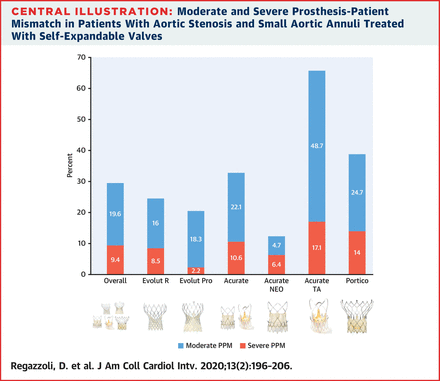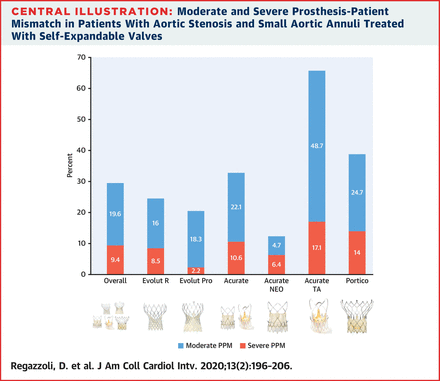Transcatheter self-expandable valve implantation for aortic stenosis in small aortic annuli: the TAVI-SMALL registry
Selected in JACC: Cardiovascular Interventions by M. Pighi
This retrospective study represents the first direct comparison among different transcatheter SEVs in patients characterized by small annuli undergoing TAVI.
References
Authors
Regazzoli D, Chiarito M, Cannata F, Pagnesi M, Miura M, Ziviello F, Picci A, Reifart J, De Marco F, Bedogni F, Adamo M, Curello S, Teles R, Taramasso M, Barbanti M, Tamburino C, Stefanini GG, Mangieri A, Giannini F, Pagnotta PA, Maisano F, Kim WK, Van Mieghem NM, Colombo A, Reimers B, Latib A
Reference
JACC Cardiovasc Interv. 2020 Jan 27;13(2):196-206.
Published
27 January 2020
Link
Read the abstractReviewer
My Comment
Why this study? – the rationale/objective
Patients with a small aortic annulus (CT-scan annular perimeter <72 mm or area <400 mm2) who undergo aortic valve replacement have a high risk of prosthesis-patient mismatch (PPM). PPM was demonstrated to worsen both hemodynamic and clinical outcomes. Several analyses showed better hemodynamic results and lower rates of PPM with percutaneous valves implantation when compared to surgery.
The present retrospective study represents the first direct comparison among different transcatheter self-expandable valves (SEVs) in patients characterized by small annuli undergoing transcatheter aortic valve implantation (TAVI).
How was it executed? – the methodology
- Multicentre retrospective registry including 859 consecutive patients with a small aortic annulus (defined as CT-scan annular perimeter <72 mm or area <400 mm2) undergoing TAVI with different self-expandable valves SEVs (Evolut R 397; Evolut PRO 84; Acurate 201; Portico 177);
- The primary endpoints of the study were post-procedure mean aortic gradient, indexed effective orifice area (iEOA), and the rate of severe PPM (iEOA <0,65 cm2/m2).
What is the main result?
- TAVI with SEVs was associated with good hemodynamic and clinic results with low rates of PPM in patients with small annuli;
- The supra-annular leaflets position of some SEVs (Evolut R, Evolut Pro, Acurate) was associated with a larger post-procedural iEOA and a lower transvalvular gradient.
- Peri-valvular leaks after TAVI are infrequent in patients with small annuli;
- Portico valve showed slightly worse results in terms of performance among SEVs, with Portico THV presenting significantly higher mean gradient, lower iEOA, and higher rates of moderate PPM compared to the Evolut R and Evolut PRO THVs.
Critical reading and the relevance for clinical practice
The TAVI-SMALL study presents the results of the first direct comparison among patients treated with different SEVs implanted in patients with small annuli. Annular size is recognized as one of the most relevant anatomical features for the planning of TAVI procedures, impacting on both short-term outcomes, in terms of paravalvular leaks (PVL), post-procedural gradients and effective orifice area, as well as mid-term clinical outcomes.
A relevant aspect of this article is the significant differences in terms of performance among SEVs, with Portico THV presenting significantly higher mean gradient, lower iEOA, and higher rates of moderate PPM compared to the Evolut R and Evolut PRO THVs. Portico THV and Acurate TA were found to be independently associated with moderate PPM (OR 3.00, 95% CI 1.46-6.16, p=0.003 and OR 3.05, 95% CI 1.17-7.93, p=0.022; respectively. The authors suggest as a possible explanation for these differences the supra-annular (Evolut R, Evolut PRO, Acurate NEO) versus the intra-annular (Portico and Acurate TA) leaflet design of the prostheses.
Abdelghani et al. recently proposed this idea in the CHOICE trial and extended registry as a potential explanation for the larger effective orifice and lower residual gradients, presented by SEVs compared to balloon-expandable THVs, regardless of annular size. Hanh et al. further stressed this aspect in a recent study analyzing core lab-adjudicated echocardiographic data from both the PARTNER and the Medtronic Corevalve US Pivotal trials. Indeed, the authors stressed the importance of an integrated approach in the assessment of THV longitudinal function, comprising the measurement of iEOA, mean gradient, and Doppler velocity index (DVI).
Some limitations in the interpretation of the results are due to the lack of insights on valve oversizing, calcium distribution, multi-slice computed tomography-derived data and some post-interventional core-lab data.
The TAVI-SMALL study also represents a call for future studies investigating the long-term performance of THVs, particularly important since the recent extension of TAVI indication to low-risk patients.

Illustration credit : JACC: Cardiovascular Interventions







No comments yet!